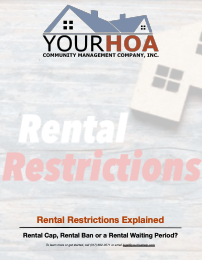There are (3) types of approaches to restricting rentals in a community.
1. Total Rental Ban: A total rental ban is more difficult to adopt than the other options since it would require the Board to convince the owners that renting is a major problem that must be dealt with. Many owners will be reluctant to approve an outright ban, even if they generally don’t want rentals in their neighborhood.
This is most commonly proposed when the Board of Directors as well as the homeowners know that many homes are currently owned by investors and the number of rentals is increasing.
2. Rental Cap: The second approach is to impose a “rental cap” so that no more than a certain number or percentage of homes in the community can be rented at any given time. Your Board would need to decide where to set the cap. Somewhere between 5% and 15% is typical based on the many other community associations we have helped with this kind of project. However, if there are already a high percentage of rental homes (like 30%), the Board will probably select a higher percentage such as 20% or 25%. Current landlords would be grandfathered in. The rental cap is a bit more of a headache on your end or that of your community’s management company because you really need to ensure that you know which homes are actually being rented, and then stay aware of who moves into what home, when they move in, and so forth.
That being said, we have found that a rental cap is a much easier “sell” to the owners when seeking approval as compared to a total ban.
3. Waiting Period: The third option, the waiting period, is a clause stating that an owner cannot rent his or her home for a certain number of years before being able to rent. (Two or three years are the most common choices that our Boards have selected.) A waiting period does not limit the number of rentals per se, but it ensures that the people who do rent are owners who have been living in the community for some time and have more of a vested interest in the neighborhood than an LLC or an out-of-state investment company.
The idea is to keep out the investors who have no interest in the community other than buying up homes to rent. We’ve never heard of any investors who would be willing to wait two or three years before they are permitted to rent, so adopting a waiting period will help keep those companies out of the neighborhood.
Hybrid Approach: We can also do a combination or hybrid approach, which includes both a rental cap AND a waiting period requirement. This has become one of the most popular options selected by our other HOA clients.
Whatever approach we take, current landlords would have to be grandfathered from the new restrictions. Also, we always include a “hardship” clause, which permits the Board to make exceptions in certain “hardship cases.” That is often a big “selling point” to those owners who are skeptical of how rental restrictions will impact them.
What do we do next? If the Board decides to move forward, let us know which option you prefer from the above alternative approaches. At that point, we can contact the attorney and they can assemble a rough draft of the amendment language. Once the Board approves the final draft, the next step would be to forward the draft to the owners.
Note: We strongly recommend calling for a “town hall” meeting of the owners to discuss the proposed amendments before any sort of official vote. The notice would make clear that no vote will be taken at the meeting. Rather, it is for Q&A. This is an opportune time to address problems that one or more owners may have with the proposal.
It also gives the Board a good gauge on whether it will be realistic to obtain the necessary number of approvals for the amendments for them to be adopted. Although there will be no formal vote taken at that meeting, the Board can ask for a show of hands of those in favor as well as those opposed. At the conclusion of that meeting, the Board may decide to make certain changes to improve the likelihood of the amendments being adopted, or they may decide to make no changes at all.
After the amendment language is finalized, the next step would be to call for a formal vote.
How Do We Get Started?
1. The Board should discuss and decide which of the three options mentioned above makes the most sense for your community.
2. Contact Your HOA (legal@yourhoahelp.com) to let us know you are ready to discuss the rental restriction.
3. Your HOA will put you in touch with the attorney directly.
4. They will prepare a rough draft of amendment language for the Board’s review.
5. At some point, an effort needs to be made to determine the number of current renters in the community. Note: This may take some time and investigation.
6. Finalize the draft of the amendment language.
7. Hold a “town hall” meeting of the owners for discussion purposes only (optional but strongly recommended).
8. The Board decides whether to revise any part of the draft, or whether the original draft is “good to go”.
9. At this point, the Attorney will advise you on the options available to ask for the owners to approve the amendments.
10. Once the amendments are adopted, the Attorney will put them into proper form. The president and secretary will need to sign the amendments, with notarization, and we will then have the amendments recorded at the County Recorder’s Office. They are “official” upon recording.
Remember: This is just a general overview and is not intended as an exhaustive rundown of the procedural requirements involved. The attorney can and will provide more information as to the step-by-step specifics as we work through the process.

